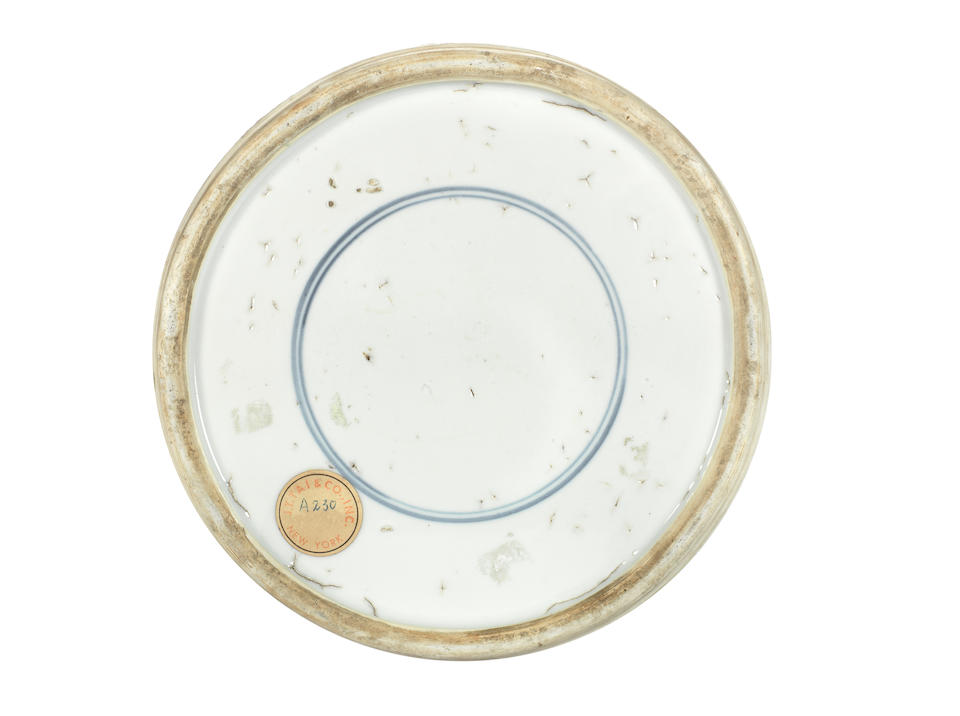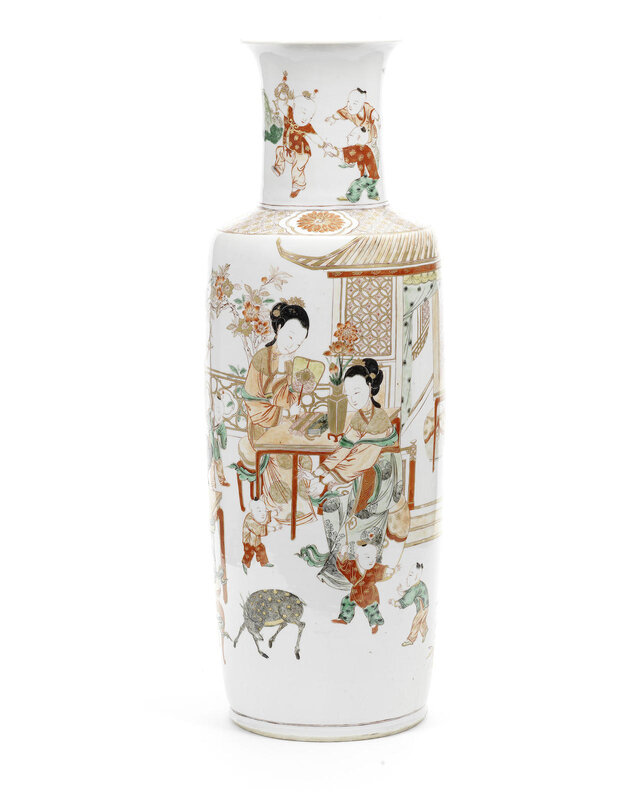A large and rare enamelled rouleau vase, Kangxi period (1662-1722)


Lot 215. A large and rare enamelled rouleau vase, Kangxi period (1662-1722); 68cm (26 3/4in) high. Estimate: £70,000-90,000. Sold for £92,500 (€128,142). Photo Bonhams.
With a sloping shoulder rising to a slightly flaring neck, boldly and vividly enamelled to the gently tapering body with a domestic scene at a fenced garden extended from a tiled pavilion with the interior revealed through the opened door, depicting two elegant ladies playing chess observed by a scholar, next to a lady holding a fan at leisure, seated at a table placed with books, scrolls and a vase holding lotus sprays, opposite to a further lady stretching out her arms to embrace an approaching child, scattered with four boys playing around their feet against a deer, all surrounded by bamboo, prunus branches, pine and wutong trees grown on rockworks, the slightly waisted neck similarly decorated with four boys attempting to reach and snatch the gilt headdress from the leaping boy wearing a cap.
Provenance: J.T. Tai Co. Inc., New York (label)
Note: Large rouleau vases of this type adorned the mansions and palaces of the wealthy and the nobility in Europe in the early eighteenth century. They were not shipped as merchandise by the Western trading companies, but were bought by individual merchants in Canton, Macao or Batavia, who could afford the investment and had the network to ship such costly items to their destinations in England, France or Holland. Unfortunately, the very nature of this private trade is the reason why we have no documentation about who shipped what letters, invoices, shipping lists and other papers have not been preserved.
The first Western owner of this vase will have enjoyed his or her new acquisition because it was grand, extremely well painted, and because it showed an exotic scene of Chinese 'Long Elisas' engaged in leisurely pursuits in an idealised domestic setting. The many symbolic meanings casually embedded in the scene will undoubtedly have been lost on the Western owner, his or her successors and their contemporaries. During the eighteenth century and for most of the nineteenth too, China was the far-away fairy-tale land, characterised by standard iconographic elements such as the elongated Chinese ladies, the playing children, the architecture, the clothing, etc. Even a minimal understanding of the decoration from within its Chinese cultural context was absent in those days.
Such vases were not just produced for export, but also perhaps even primarily for the Chinese domestic market. For a Chinese owner the decoration had several layers of meaning, adding to its overall grandeur. At first view the vase shows a well-organised household, where the family members feel at ease and act according to their position; in brief, it is a visualisation of Confucian ideals. Behaviour according to the acknowledged moral rules is blessed here by the inclusion of symbols of luck, riches and long life such as the spotted deer and the lotus flowers. Interesting, too, in this context is the depiction of the five young boys on the neck of the vase. One boy, running in front of two others, holds a golden helmet high above his head, while the others try to intercept him. This scene refers to a well-known game named 'Catch the General's Helmet', and whichever boy wins is destined to become a high-ranking military leader; this will, of course, be another blessing for such a perfect family. These and other positive connotations will not have been lost on a Chinese owner of the vase or those who admired it in the study or studio where it was prominently exhibited.
The question whether this vase was produced for export or for the domestic market is therefore irrelevant, because such high-quality porcelains served the needs of many. They were undoubtedly exported, as proven by comparable grand pieces in well-documented eighteenth-century collections, for instance, the Royal Collection of Augustus the Strong in Dresden, Germany. But they also were bought by Chinese literati and connoisseurs. Such multi-marketing by the porcelain workshops in Jingdezhen was particularly strong during the later Kangxi period, around 1700, when the economic situation in China as well as in Europe facilitated the sale of such costly items.
From an art-historical point of view it is interesting to note how this vase shows a combination of overglaze enamels of the famille verte type and a lavish use of rouge de fer. The latter, an overglaze iron-red enamel, is applied here in several grades of red. Objects with rouge de fer decorations became popular at the end of the seventeenth century and even formed a group of their own with typical Kangxi decorations done in red and gold only. On this vase, various enamel colours are skillfully applied and give the scene a more lively appearance than would have been the case if only rouge de fer were used. In order not to distract the eye from the figures in the interior and on the terrace, the section that encloses and connects the scene is painted with trees, bamboo and rocks in a light palette with only a few accents in green.
A closely related pair of vases is illustrated by E.Ströber, 'La maladie de porcelaine...' East Asian Porcelain from the Collection of Augustus the Strong, Berlin, 2001, no.33, pp.80-81. For other similar examples, see L.Hájek and W.Forman, A Book of Chinese Art: Four thousand years of sculpture, painting, bronze, jade, lacquer and porcelain, London, 1966, no.64 (left), in the collection of the National Gallery, Prague; and C.Samoyault-Verlet, Le Musée chinois de L'impératrice Eugénie, 1986, pp.24-25, fig.17, in the Chinese Museum at Fontainebleau established by Empress Eugénie in 1863.
For smaller rouleau vases decorated with similar subjects, but enamelled in more conventional famille verte, see J.Ayers, The Mount Trust Collection of Chinese Art, London, 1970, no.103; and Tie Yuan, The Complete Collection of Porcelain of Jiangxi Province: Porcelain of the Qing Dynasty I, 2005, p.53, in the collection of the Jingdezhen Museum of Pottery and Porcelain.
Bonhams. FINE CHINESE ART, 14 May 2015 10:00 BST - LONDON, NEW BOND STREET

/https%3A%2F%2Fprofilepics.canalblog.com%2Fprofilepics%2F1%2F0%2F100183.jpg)
/https%3A%2F%2Fstorage.canalblog.com%2F03%2F02%2F119589%2F96711876_o.jpg)
/https%3A%2F%2Fstorage.canalblog.com%2F11%2F31%2F119589%2F94773502_o.jpg)
/https%3A%2F%2Fstorage.canalblog.com%2F20%2F83%2F119589%2F94772815_o.jpg)
/https%3A%2F%2Fstorage.canalblog.com%2F26%2F72%2F119589%2F75604929_o.jpg)
/https%3A%2F%2Fstorage.canalblog.com%2F59%2F60%2F119589%2F26458628_o.jpg)



/image%2F1371349%2F20240331%2Fob_0d7487_2024-nyr-22642-0859-000-an-unusual-sma.jpg)
/image%2F1371349%2F20240331%2Fob_a6f470_2024-nyr-22642-0857-000-a-large-black.jpg)
/image%2F1371349%2F20240329%2Fob_2f6b6c_854-1.jpg)
/image%2F1371349%2F20240329%2Fob_825c4d_2024-nyr-22642-0851-000-a-rare-black-g.jpg)